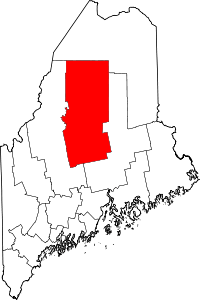Blanchard, Maine
Blanchard is an unorganized territory (township) in Piscataquis County, Maine, United States. The population was 98 at the 2010 census.
Blanchard, Maine | |
|---|---|
 Location in Piscataquis County and the state of Maine. | |
| Coordinates: 45°16′03″N 69°35′01″W | |
| Country | United States |
| State | Maine |
| County | Piscataquis |
| Area | |
| • Total | 45.0 sq mi (116.5 km2) |
| • Land | 44.3 sq mi (114.8 km2) |
| • Water | 0.7 sq mi (1.7 km2) |
| Elevation | 1,122 ft (342 m) |
| Population (2010) | |
| • Total | 98 |
| • Density | 2.2/sq mi (0.84/km2) |
| Time zone | UTC-5 (Eastern (EST)) |
| • Summer (DST) | UTC-4 (EDT) |
| ZIP code | 04406 |
| Area code(s) | 207 |
| FIPS code | 23-05560 |
| GNIS feature ID | 2378258 |
Geography
According to the United States Census Bureau, the unorganized territory has a total area of 45.0 square miles (116.5 km2), of which, 44.3 square miles (114.8 km2) of it is land and 0.7 square miles (1.7 km2) of it (1.47%) is water.
Climate
This climatic region is typified by large seasonal temperature differences, with warm to hot (and often humid) summers and cold (sometimes severely cold) winters. According to the Köppen Climate Classification system, Blanchard has a humid continental climate, abbreviated "Dfb" on climate maps.[1]
Notable residents
Thomas Davee of Blanchard was a U.S. Congressman and a member of the Maine State Senate in the 19th century.
Before moving to Monson, photographer Berenice Abbott, famous for her 1930s views of New York streets and buildings, lived in Blanchard during the 1950s.
Demographics
| Historical population | |||
|---|---|---|---|
| Census | Pop. | %± | |
| 1840 | 270 | — | |
| 1850 | 192 | −28.9% | |
| 1860 | 164 | −14.6% | |
| 1870 | 164 | 0.0% | |
| 1880 | 167 | 1.8% | |
| 1890 | 213 | 27.5% | |
| 1900 | 248 | 16.4% | |
| 1910 | 175 | −29.4% | |
| 1920 | 124 | −29.1% | |
| 1930 | 104 | −16.1% | |
| 1940 | 118 | 13.5% | |
| 1950 | 75 | −36.4% | |
| 1960 | 57 | −24.0% | |
| 1970 | 56 | −1.8% | |
| 1980 | 64 | 14.3% | |
| 1990 | 78 | 21.9% | |
| 2000 | 83 | 6.4% | |
| 2010 | 98 | 18.1% | |
| Est. 2014 | 97 | [2] | −1.0% |
| U.S. Decennial Census[3] | |||
As of the census[4] of 2000, there were 83 people, 42 households, and 23 families residing in the unorganized territory. The population density was 1.9 people per square mile (0.7/km2). There were 148 housing units at an average density of 3.3/sq mi (1.3/km2). The racial makeup of the unorganized territory was 98.80% White, and 1.20% from two or more races.
There were 42 households, out of which 21.4% had children under the age of 18 living with them, 52.4% were married couples living together, 2.4% had a female householder with no husband present, and 42.9% were non-families. 42.9% of all households were made up of individuals, and 9.5% had someone living alone who was 65 years of age or older. The average household size was 1.98 and the average family size was 2.71.
In the unorganized territory the population was spread out, with 20.5% under the age of 18, 3.6% from 18 to 24, 27.7% from 25 to 44, 37.3% from 45 to 64, and 10.8% who were 65 years of age or older. The median age was 45 years. For every 100 females, there were 124.3 males. For every 100 females age 18 and over, there were 112.9 males.
The median income for a household in the unorganized territory was $13,250, and the median income for a family was $45,625. Males had a median income of $25,625 versus $27,500 for females. The per capita income for the unorganized territory was $12,571. There were 15.8% of families and 33.3% of the population living below the poverty line, including 26.7% of under eighteens and 22.2% of those over 64.
References
- Climate Summary for Blanchard, Maine
- "Annual Estimates of the Resident Population for Incorporated Places: April 1, 2010 to July 1, 2014". Archived from the original on 2015-05-23. Retrieved June 4, 2015.
- "Census of Population and Housing". Census.gov. Retrieved June 4, 2015.
- "U.S. Census website". United States Census Bureau. Retrieved 2008-01-31.
